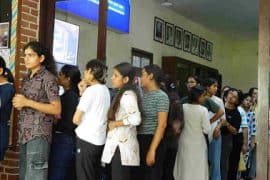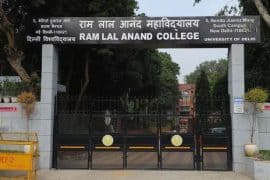For most people, February 9th will be just another day in the calendar. But, in the history of student movements, this day will be known for the beginning of a remarkable battle between the sedition-professing state and the students, who advocated absolute freedom of expression. This row erupted after a public event organized by a few students corroborating the judicial killing of Afzal Guru and demanding the right to self-determination of Kashmir dominated the public discourse for months and in the process raised many plausible questions pertaining to nationalism, dissent, activism, politics, and policies. Yes, we’re talking about the famous (or infamous) JNU Sedition Row.
Here is a look at the sequence of events:
• A program organized by a few students, including Umar Khalid and Anirban Bhattacharya ,against the execution of Afzal Guru and for Kashmir’s right to ‘self-determination’ takes place on the evening of 9th February, 2016. Akhil Bharatiya Vidyarthi Parishad (ABVP) protests against this event and a scuffle takes place. Meanwhile, a few media channels (mainly Zee News) that were present at the ground report that anti-India slogans such as “Bharat ki barbara di tak jung rahegi” and “Bharat tere turkey hongay” were raised and contested videos of the same are widely circulated.
• On February 12th, Kanhyaiya Kumar, then JNU Students Union(JNUSU) president is arrested by Delhi Police for sedition and criminal conspiracy. Many JNU students are booked for the same; five of them go into hiding. Protests in support of Kanhiya Kumar, Umar Khalid, and Anirban Bhattacharya erupt.
• On February 15th and 16th, there is mob violence outside Patiala House Court during the hearing of Kanhiya Kumar. Journalist, JNU teachers, Kanhaiya Kumar himself, and activists are assaulted by a group of lawyers.
• On February 17th, JNU faculty members start open lecture series on Nationalism and 133 eminent professors from prestigious universities, including Noam Chomsky, writes a letter condemning the arrest of Kanhaiya Kumar, and expresses solidarity with the students and faculty.
• On February 18t,h three office-bearers of JNU unit of ABVP resigned by stating disagreement over the Centre’s crass handling of the matter.
• On February 21st, all the absconding students return to the campus and offer themselves for surrender.
• On February 24th, Delhi Police arrests Umar Khalid and Anirban Bhattacharya.
• On March 24th Kanhyaiya Kumar returns to JNU amidst much media attention.
• On March 19, Umar Khalid and Anirban Bhattacharya are released on bail and subsequently address the huge gathering at JNU’s administrative block.
• On April 26th, varsity’s inquiry committee found 21 students guilty of breaking disciplinary norms, the Student’s Union and Jawaharlal Nehru University Teachers’ Association (JNUTA) rejects the punishments.
• On 10th and 12th May, rusticated students move to the Delhi High Court against their rustication.
• On May 13th, High Court stays the disciplinary action against the students.
A slew of confrontations and protests between students, teachers, and administration regarding multiple issues continued throughout the year.
The best and worst of media coverage
The reason why a seemingly small public meeting, which is typical of a politically charged campus like JNU, became a subject of prime time after prime time was not because the media was interested in discussing the controversial trial of Afzal Guru, the Kashmir problem or student politics, but because an incident was blown of out proportion to suit another agenda altogether. The narratives that many sections of media weaved reduced many complex issues into simplistic binaries and the dangerous Bush discourse of “you’re either with us, or against us” was created. The media trial that was run against students and against JNU as an institution itself incited violence towards the accused and jeopardized their safety. Multiple false claims such as: Umar Khalid visited Pakistan (except that he doesn’t hold a passport) and that he made 800 calls to Gulf countries in 4 days (which means 8.9 calls per hour) were callously thrown around. Mainstream media houses like News X quoted an unverified Intelligence Bureau document and announced Umar Khalid a Jaish-e-Mohammad terrorist, but conveniently forgot to add a correction disclaimer when Intelligence Bureau denied any such findings. Even Home Minister Rajnath Singh made an unsusceptible statement saying that “The incident at JNU has received support from Hafiz Saeed“. With an enthusiastic circulation of morphed videos and jingoistic shooting matches, JNU row could be seen as a perfect example where certain section of media lost its credibility to some vested interests.
However, while it was the worst of times, it was also the best of times. Independent and alternative portals like Newslaundy, The Wire, ScoopWhoop, Catch News, National Dastak and India Resists provided the much needed unbiased coverage of the whole fiasco. Taking a stand against Zee News’s propaganda laced documentation of JNU issue journalist Vishwa Deepak openly resigned from Zee Media. Somewhere in the media frenzy, we also saw journalist Ravish Kumar’s Black Screen prime time episode which was an epitome of fair reportage.
Current status of cases
The sedition cases which were to be investigated by Delhi Police’s anti-terrorism unit, the Special Cell, are presently at halt. No charge sheet has been filed. Delhi Police has seen two police commissioners in the past year and it appears that except for BS Bassi (commissioner during February 2016 who filed suo moto cases against the students) no one is interested in further pursuing the cases. This indifference is understandable since the grounds on which the charges were filed are fragile.
What changed for the anti-nationals?
Kanhaiya Kumar reached instant fame after his arrest and the much broadcasted ‘Azaadi’ speech. He bagged a book deal with publishing house Juggernaut Books and subsequently released ‘Bihar to Tihar: My Political Journey’ on 1st July 2016. Kanhaiya Kumar has addressed multiple rallies across the country in past one year.
Umar Khalid is currently working on final semester of his Ph.D which is centered on the tribals of Singhbhum district in Jharkhand. Because his face was continuously splashed across the television screen for weeks, Umar became a familiar face and unfortunately still has a fair share of haters (both online and offline). Even though the Umar is a popular activist and has been invited as a speaker to several conferences and demonstrations, he still faces security issues as a result of the vilification.
Shehla Rashid Shora, Vice President of JNUSU 2015-16 spearheaded the stand with JNU movement and represented the university in all major forums. She has signed a book deal with Penguin Random House. Her book titled ‘I, Student’ is expected to hit the stands this year.
A year on, five of those six students at the heart of the controversy are still studying at the university except for Anirban Bhattacharya, who left after submitting his Ph.D. thesis. Currently, he works as a researcher with a Delhi-based think tank.
Questions that remain unanswered
It’s been one year since the arrests were made and an esteemed institution was equated as ‘the den of terrorists’. However, unlike last year, T.V studios are now busy covering the Uttar Pradesh elections, those self-righteous anchor-students who were baying for the blood of so-called ‘anti-nationals’ are today silent on the police and state inaction. The question arises: Should the media be held accountable for the victimization of students? Should Delhi Police, which actively raided hostels and made arrests be asked about the developments of the case? It is still unclear who were the people who raised the anti-India slogans or if at all there was any sloganeering.
However, what is clear is that Jawaharlal Nehru University students are stronger than ever: They are still dissenting despite the grills that are installed at the administrative block. Yes, their protests are not being televised but they sure are alive.
Niharika Dabral
[email protected]
Image Credits: Anindito Mukherjee/Reuters




Comments are closed.